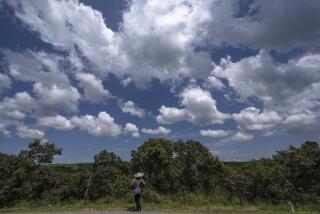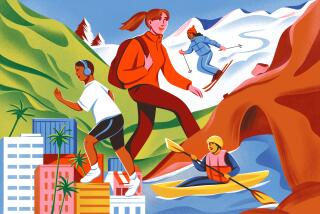Seeing Best of Burma in 7 Days
- Share via
RANGOON, Burma — The road from the high plateau at Taunggyi descends in hairpin bends to a valley of tans and greens, now pungent with the scent of wood smoke that settles like mist over scattered villages.
Shafts of sunlight break through the early morning haze, falling in golden pools on fields of ripening grain.
The astonishing beauty of its rural landscape is Burma’s chief glory. Unfortunately, your introduction to this enthralling country is considerably less idyllic.
All visitors enter through Rangoon, the capital. Once a stately enclave of British colonialism, it has wide, tree-lined boulevards and solid Victorian buildings set back in tropical gardens.
A closer look shows the decay of splintered sidewalks and crumbling facades. Crows pick at carrion in the streets. Touts tugging at shirt sleeves whisper urgent offers to buy cigarettes, whiskey--anything they can resell on the flourishing black market.
Hairs of Buddha
Except for the gilded splendor of its most famous monument, the Shwedagon Pagoda--whose massive bell-shaped spire, or stupa, is said to enshrine eight hairs of Buddha--the city holds little appeal for tourists.
Elsewhere, it’s a different story. Although Burma remains an impoverished socialist country that shuns contacts with the outside world, for a trickle of foreign visitors it is a pagoda-studded wonderland, quaintly charming and distinctly Southeast Asian in its self-imposed isolation.
To savor the ancient, unspoiled Burma, roam inland to the mountain fastness of Taunggyi and the secluded grandeur of Inle Lake.
Climb the hill of Mandalay and explore the storied Irrawaddy River as far as the deserted city of Mingun. Above all, linger amid the ruins of Pagan, with their 1,000-year-old echoes of the nation’s Buddhist past.
Prop Plane Hopping
Distances are vast and tourist visas good for only seven days, so don’t waste precious time in long-haul trains and buses. The quickest way to get around is on Burma Airways prop planes.
From Rangoon your first hop is 300 miles north to a mountain town called Heho. From there, travelers usually go straight to nearby Taunggyi by road.
The drive is through a windblown savanna rimmed by saw-toothed ridges. You pass villages with houses of bamboo strips woven like baskets in herringbone patterns. Men and women alike wear graceful longyis, ankle-length sarongs gathered in a tuck at the waist.
Visitors are still a novelty in the hinterland and children with brown faces and enchanting smiles rush up to your camera eager to pose. They ask and expect nothing in return.
Taunggyi’s prime attraction is its open-air market, where colorfully garbed people from the region’s Shan hill tribes sell their produce and handicrafts. Traditional Burmese marionettes are best buys for about $30. Gorgeously arrayed, they make stunning souvenirs.
Touring Inle Lake
An hour’s ride from Taunggyi is Inle Lake, a place of haunting loveliness. Treeless crags rise from the shore, their Moorish flanks dappled with cloud shadow.
Touring here is by boat. Starting at Yaungwhe village, narrow excursion launches slice through silted shallows choked with hyacinth.
In the deeps the water becomes clear as glass, with only occasional tufts of weeds drifting by. Fishermen row their sampans standing on one leg, the other wrapped around a sculling oar.
A sprinkling of floating markets and the stalls around the Phaungdaw Pagoda, on the nine-mile lake’s western edge, display superb examples of Shan folk art.
You can buy bright cotton shoulder bags for $5 to $15 and wonderfully sequined and embroidered wall tapestries for $10 to $100.
Images of Mandalay
After Inle Lake, fly north to Mandalay. At one time the home of kings, the city remains the center of Burmese culture and religion.
Images stand out: bullock carts kicking up dust; the huge stone griffins--half eagle, half lion--that guard the base of Mandalay Hill; the clusters of novice Buddhist priests, their teeth stained as red as their robes from chewing narcotic betel nuts.
Spend a morning on Mandalay Hill. The trek is exhausting, the prospect matchless. From the 800-foot summit you look down across walled vestiges of what was once a royal palace to the wide Irrawaddy, Burma’s great river highway, shimmering like metal in a sun-scorched plain.
At night, Mandalay works a special magic. Hire a horse-drawn jitney for $3 and prowl the streets behind the Mandalay Hotel. You slip into another century. There is no motor traffic and the air is redolent of dust and dung. Horse carts loom up out of the dark, candles guttering in brass side lamps.
Families squat around their cooking fires at the edge of the road. Kerosene lanterns glimmer in recessed doorways. The only sounds you hear are the squeals of passing bicycle tires and the hollow clatter of horses’ hoofs.
A Ringing 87 Tons
From Mandalay, take a seven-mile boat ride up the Irrawaddy to medieval Mingun, celebrated for the massive ruins of an 18th-Century pagoda and for the world’s largest intact bell, weighing 87 tons.
Antiquities aside, Mingun’s appeal is in the journey; it offers a fascinating glimpse of life on the river.
The steep dirt Mandalay bank teems with shacks on stilts. Naked children splash near the shore and women pummel laundry on flat rocks. Soon you pass sandy littorals dotted with fishing villages and a scattering of white pagodas. The trip costs 50 cents and takes about an hour.
Finally, there is Pagan. Sunset is the best time to view the old royal city, and the 200-foot Thatbyinnyu Pagoda is the perfect vantage point. From an upper parapet you survey an immense plain that stretches beyond the Irrawaddy to a scribble of purple hills.
Far into the distance, hundreds of weathered brick pagodas rise like blunted spikes from the dusty earth. In the soft red glow of dusk the thousand-year-old pinnacles stand picked out in shadow, mysterious monuments to Buddhist gods.
Pagan is an extraordinary spectacle. The temples and the bare, noble landscape in which they stand are the essence of Burma, an obligatory stop on any itinerary.
-- -- --
Because of the difficulties in obtaining and confirming plane and hotel reservations in Burma, independent travel is recommended only for experienced visitors.
If it’s your first trip, take a guided tour. Abercrombie & Kent, an international tour operator, features seven days in the locales mentioned above as part of its 19-day “Golden Buddhas” outing to Thailand and Burma.
The cost of the two-country package is $3,750, plus round-trip air fare from U.S. gateways. (On request, the firm will arrange custom travel solely to Burma.)
Contact Abercrombie & Kent, 1420 Kensington Road, Oak Brook, Ill. 60521, or telephone (800) 323-7308 or (312) 954-2944).
Also arranging trips to Burma are Lindblad Travel (Box 912, 1 Sylvan Road N., Westport, Conn. 06881, telephone (800) 243-5657 or (203) 226-8531), and Society Expeditions, 3131 Elliott Ave., Seattle, Wash., 98121, telephone (800) 426-7794 or (206) 285-9400.
Most visitors fly by way of Bangkok. United Airlines provides nationwide connections through San Francisco. Northwest flies from Seattle and Thai Airways International from Dallas and Seattle. Round-trip economy fares average $1,000, plus a $200 supplement for Bangkok to Rangoon and back.
Travel in Burma is demanding. Accommodations are Spartan; the food is ample but undistinguished (curries are a staple). The cool season, November through February, is the best time to tour. Drink only bottled water, soda or beer; avoid ice cubes. Recommended reading: “Insight Guide to Burma” and “Burma: A Travel Survival Kit,” available in U.S. bookstores.
During baggage checks at Rangoon Airport, officials openly solicit “gifts” of anything that catches their fancy: flashlights, radios, cigarettes. Don’t be intimidated. Say “no,” politely but firmly.
Contact the Embassy of the Union of Burma, 2300 S St. N.W., Washington, D.C. 20008, phone (202) 332-9044.
More to Read
Sign up for The Wild
We’ll help you find the best places to hike, bike and run, as well as the perfect silent spots for meditation and yoga.
You may occasionally receive promotional content from the Los Angeles Times.






